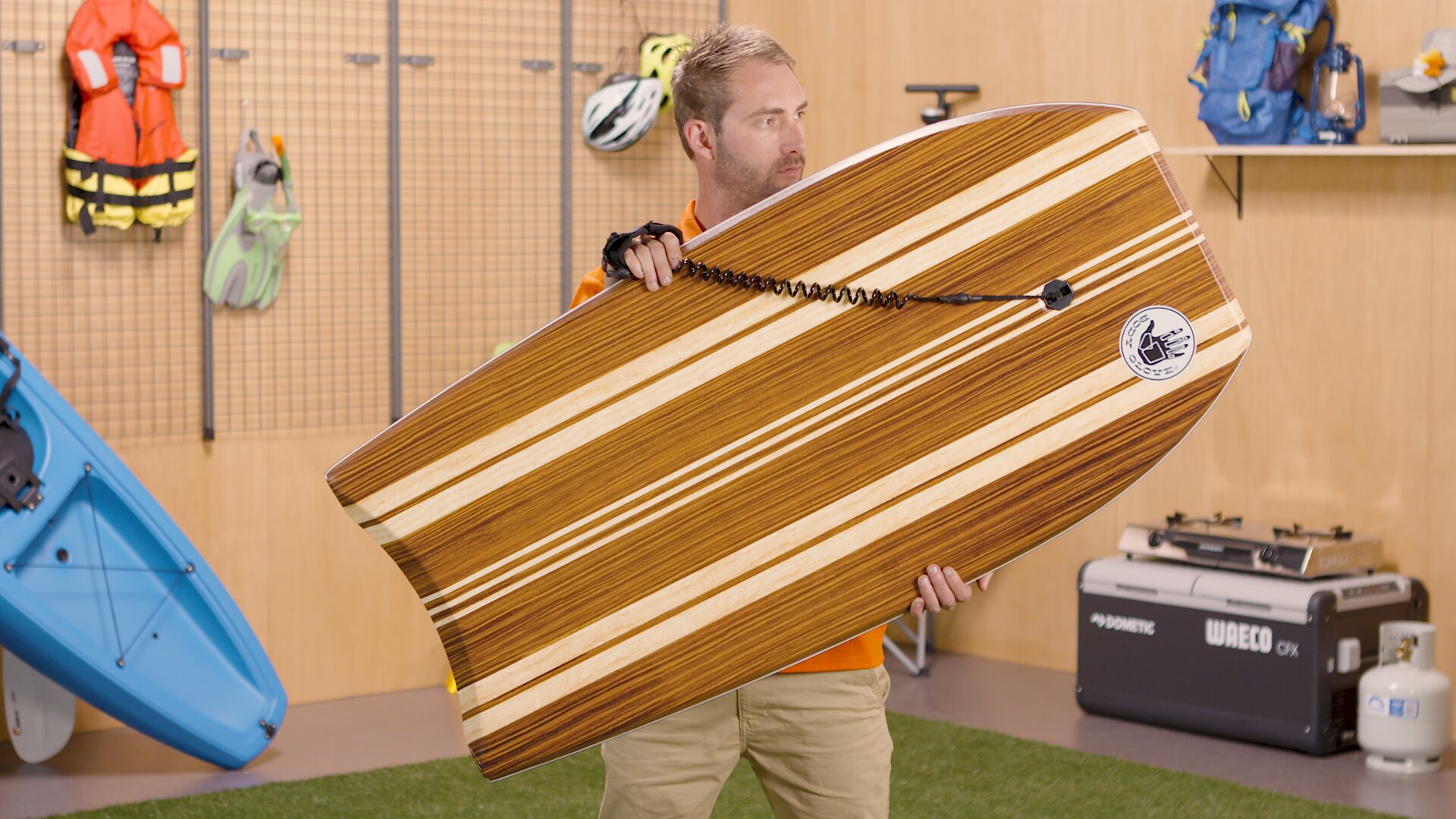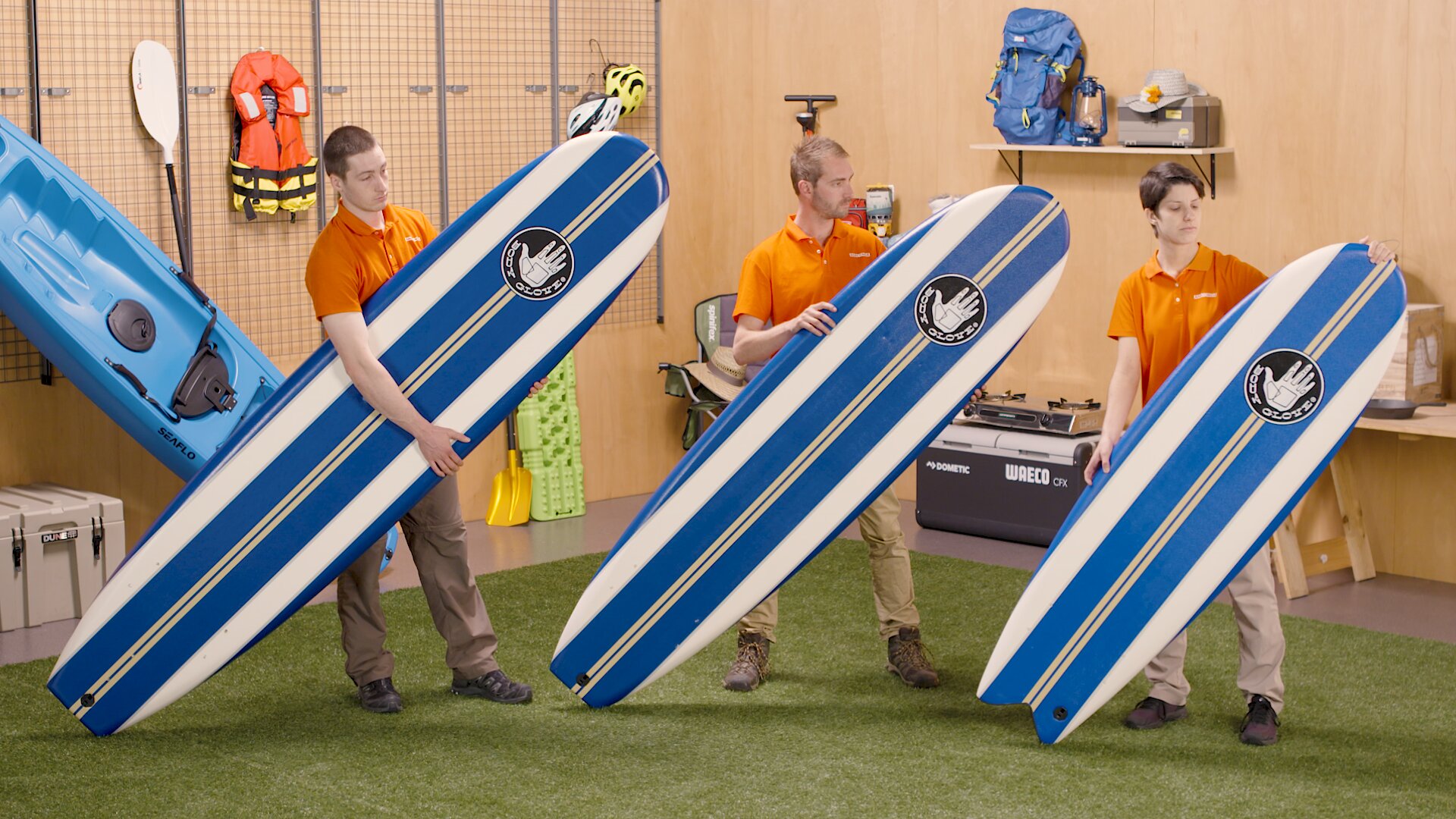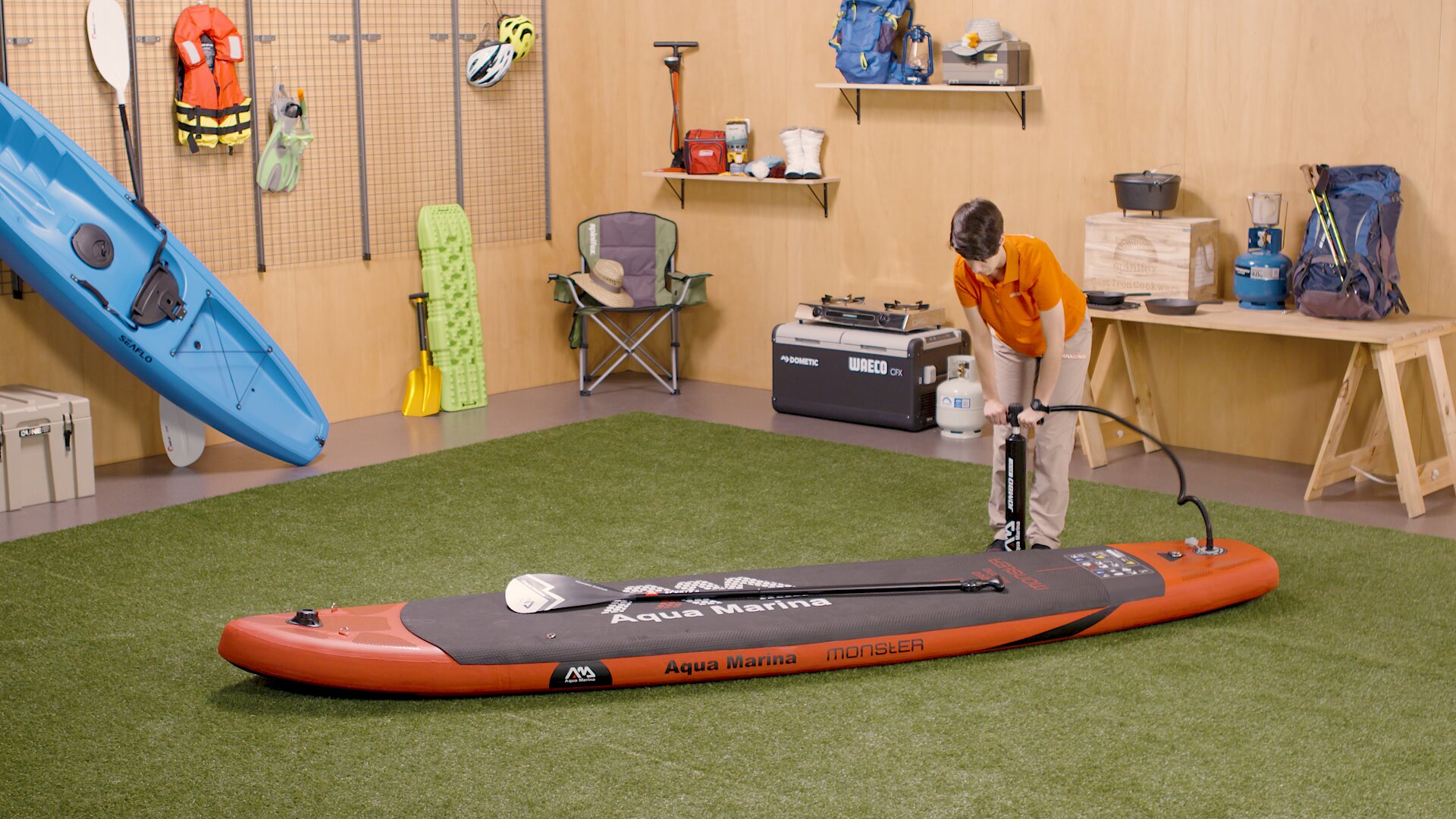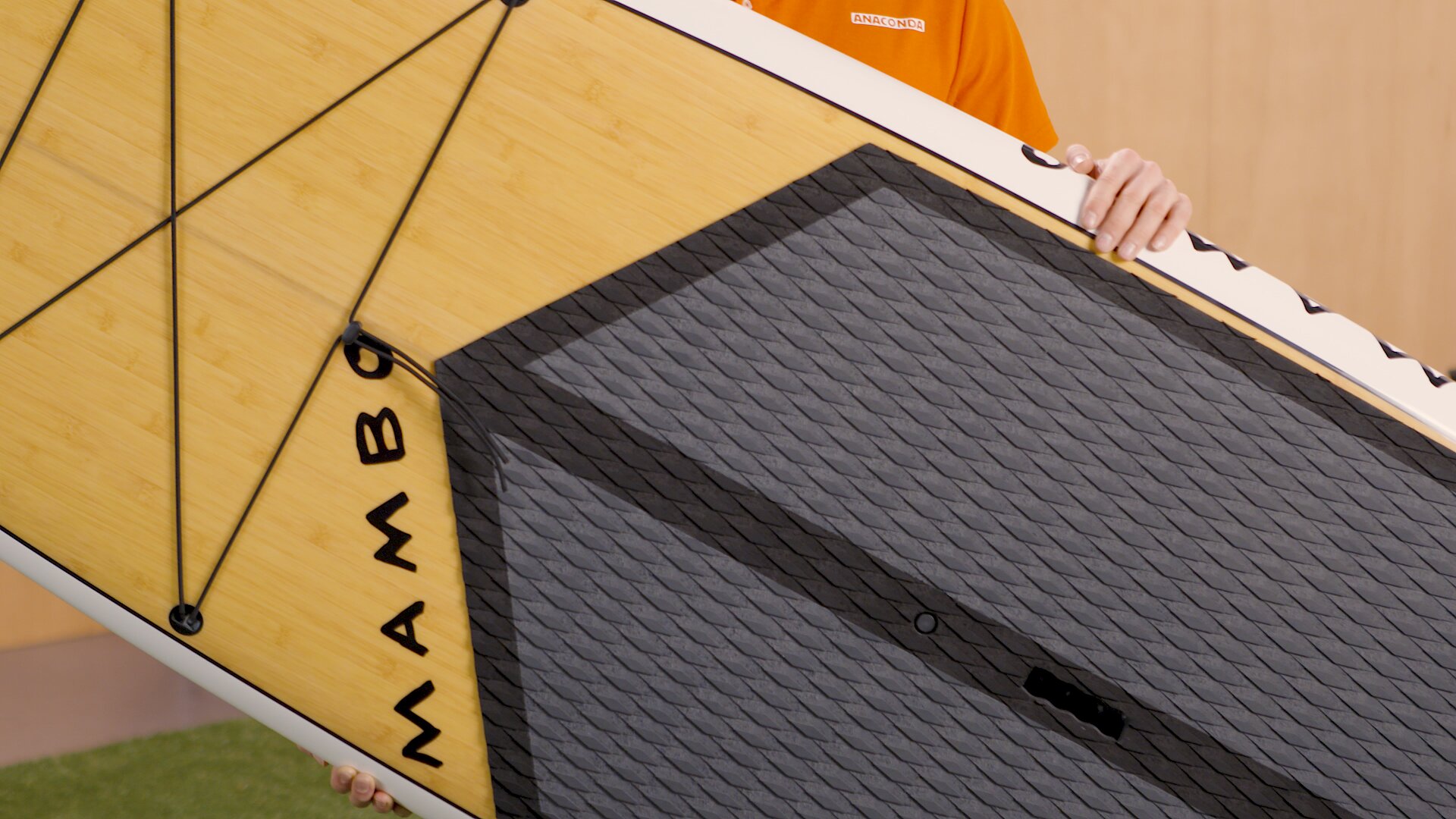| Your browser is not supported. | ||
|
Please browse our site using any of the following options:
| ||
Boards Buying Guide
Being in the water on a board is good for the soul. It's a great way to get away from it all and unwind, and you can have hours of free fun in the sun! With your own bodyboard, surfboard or stand-up paddle board you're always ready for action, and board riding is a great way to keep yourself and the kids active. Whether you prefer the beach, lakes, rivers or canals, when you've got a board you'll never be bored! However, how do you know what type of board is best for you and your specific needs? No worries, because our team of board experts at Anaconda have come together to create this Board Buying Guide to give you all the information you need to know to make the right decision for you.
Quick Links
- What's The Best Stand Up Paddle Board, Surfboard & Bodyboard?
- The Different Types Of Boards
- How To Choose The Right Board Size
- Types Of Board Materials
- Board Essentials To Consider
- Board Quality
What's The Best Stand Up Paddle Board, Surfboard & Bodyboard?
Everyone's different, and like many things in life, what's best for one person might not be best for the next. The best board for you depends on certain important factors such as:
- Who will be using the board (kids or adults, and how tall, heavy, fit and experienced are they?)
- Where you'll be using the board (stand-up paddle boarding in the surf or still waters?)
- Whether you can carry it and take it in the car (is it heavy and do you have/need roof racks?)
- How quick and easy you want using the board to be (immediately or with some practice?)
- How often you'll be using the board and for how long (rarely or for hours every weekend?)
- How long you want it to last (for a few summer days or years of beach days and camping?)
The Different Types Of Boards
It’s good to know what the main different types of boards are before you make your purchase. Do you want to glide through the waves or cruise along the water? Do you prefer to kneel, stand or lay down? Here we will break down the main different types of boards to find which one is best suited to your needs.
Bodyboards
A bodyboard, also known as a boogie board, is very easy for everyone to ride waves on straight away. They are a lot less tiring and safer to use than a regular surfboard. Bodyboards are shorter and wider than a surfboard, making them more stable. Bodyboards are ridden lying down or on one knee, depending on how you choose to live your life. When comparing bodyboards, be sure to consider these six important factors:

- Surface Grip - A better grip makes it harder to slip off.
- Tail Shape - A bat tail gives you more speed but is harder to control.
- The Sides - Straight sides are faster than rounded, but harder to control.
- Stringer Rod - Keeps the board stiff so it lasts longer.
- Channels - Grooves on the underside give you more control.
- Leash Connection - Essential if you'll be using it to ride waves at the beach.
Stand Up Paddle Boards
A stand up paddle board is ridden by standing or kneeling on the board and pushing yourself forward with a paddle. They are great for building up your core strength. You can ride a stand up paddle board along small waves or on flat water and is a fun and relaxing way to stay active while reconnecting with nature. When comparing stand up paddle boards, here are seven important factors to consider:

- Surface Grip - A better grip makes it harder to slip off.
- Underside Shape - A curved bottom is less stable but easier to control.
- Tail Shape - A wider, rounder tail is more stable but harder to control.
- Nose Shape - Curved is best for surf waves and narrow is better for flat water and racing.
- Leash Connection - Essential if you'll be using it to ride waves at the beach.
- Carry Handles - SUP boards with handles are easier to get in and out of the water.
- Fins - More fins give you more control and if they're tough they'll last longer.
Surfboards
A surfboard is trickier to use than a bodyboard or a stand up paddle board, and is best for those prepared to commit to a fair bit of practice if it’s their first time. A surfboard is ridden by paddling out into the waves with your arms while lying face down, and then turned to face the shore at the point the waves start to rise. Different types of surfboards are designed for specific conditions and riding styles. Common types include shortboards, longboards, fishboards and funboards. Choose one that suits your preferences and the type of waves you'll be riding. The tail shape influences the board's turning ability and common tail shapes include squash, round and pintail. Different tail shapes are better suited for different wave conditions. The number and configuration of fins (single, twin, thruster and quad) affect a board's stability and maneuverability. Experimenting with different fin setups can help you find the one that suits your style.

Skimboards
A skimboard is basically a miniature surfboard and is used to ride tiny waves that break right onto the sand on the shoreline. A skimboard is held while running on the sand, then dropping the board and jumping on the skim the water. Skimboards are best for those prepared to commit to a fair bit of practice and are usually used by those who are already experienced in surfing. A skimboard with a round nose will provide stability and is suitable for beginners, whereas a pointed nose will enhance maneuverability and is better for experienced riders.
Kneeboards
A kneeboard is designed for riders to kneel on while being towed behind a boat. It is used for various water activities and is popular for its versatility and ease of use. A kneeboard typically has a rectangular or slightly contoured shape with padded knee wells and a strap or hook to secure the rider's knees in place. Some kneeboards have fins on the bottom to improve tracking and stability on the water. Kneeboarding is accessible to riders of different skill levels, making it suitable for both beginners and experienced water sports enthusiasts.
How To Choose The Right Board Size

The size of the board needs to be right for your height, weight and experience. You'll also need to be able to carry it and get it into your car (or use roof racks).
Bodyboard Sizes
Bodyboards are the smallest type of board, so it's easy to throw a few in the boot for beach fun. The bodyboard you choose needs to be the right size so it stays afloat and is easy to control. To choose the right size bodyboard, stand a few boards up on one end and hold them beside you. The bodyboard that's close to being in line with your belly button is the right size. If it's for a child, get a bodyboard that's a bit higher than their belly button (so there's room to grow). Make sure they're strong enough and have long enough arms to carry it. Choose the bodyboard shape that suits the rider's level of experience.
For Kids & Beginners
A bodyboard that has a wide nose will create more stability on the board than a bodyboard with a narrow nose. A crescent-shaped tail is easier to control than a bodyboard with a bat-wing tail. Lastly, a bodyboard that bends upwards at one or both ends (so has a rocker) is going to be more stable, slower and easier to control.
For Experienced Riders
A bodyboard with a narrow nose is going to be easier to control than one that has a wide nose - but will be less stable. A bodyboard that has a bat-wing-shaped tail is going to be faster and much better for doing tricks. A flat bodyboard (with no rocker) is going to be fast as well - but will have less stability and will be harder to control.
Stand Up Paddle Board Sizes
Stand up paddle boards can be used in still water such as flat beaches, rivers and lakes. To choose the right stand up paddle board size, the length needs to suit your size, experience and how you'll use it. If you're small and light, then you'll need a smaller board - and a bigger board if you're tall and heavy. If you're a beginner, a bigger board gives you more stability and is easier to balance on.
For Beginners
Long SUP boards are more stable and easier to balance on, so they're best for beginners. A stand up paddle board with a pointy nose cuts through the water better than one with a round nose. Shorter SUP boards with a narrow nose and/or tail and a rocker (curve) are more sensitive, so they're best for experienced riders and surf competitions. A SUP board that's not too long or wide is a good all-rounder for flat water and small waves.
For Experienced Riders
A light, narrow, 12ft 6in to 14ft stand up paddle board with a pointy nose is fast (but less stable) for racing. Experienced SUP boarders will care more about the board shape, weight and fins. If you want to fit more than one person on a stand up paddle board, then you'll need a bigger board. Some SUP boards come with a paddle included while others don't, so you may need to buy one separately.
Choosing A Paddle Size
When it comes to choosing the right paddle size, a small light paddle is easier to move through the water and is better for beginners. A heavy paddle is harder to move through the water but gives experienced riders more power. If you're shorter, you'll need a shorter paddle, and if you're tall, you'll need a taller paddle. If you're using your SUP board to surf waves then a shorter paddle will be better. An adjustable paddle can be lengthened in still water, shortened in waves and shared. To get a feel for the best size paddle for you, try a few at your nearest Anaconda store. Most SUPs are 2.4 metres to 14.2 metres (8-14 feet), so you'll need roof racks if transporting on your car.
Surfboard Sizes
Your surfboard needs to suit your height, weight and level of experience. Longer and wider surfboards are easier to paddle and are very stable in the water, but are harder to control. The fins on the bottom give you stability when changing direction and can be swapped. Bigger fins give you more stability (but less control, so it's harder to do tricks) and smaller fins will give you more control (so you can do tricks but have less stability). If you're a beginner, a bigger surfboard gives you more stability and helps you float better. If you're small and light, then you'll need a smaller surfboard. Experienced surfers will care more about the shape, weight, fins and rails for tricks. The volume in litres also matters. High-volume boards are more stable and are easier to surf on, making them better for beginners. Low-volume boards are more sensitive, so they’re best for experienced surfers and tricks. Try using a few different surfboards to find the size you like. As you get better you may want to upgrade your board to suit your level of ability or just have a few boards for different surf conditions. Most surfboards are 150-300cm long and 45-65cm wide, so check whether you can fit the board you want in the car or if you'll need to put it on roof racks.
Bodyboards Size Chart
Height (inches/feet) | Bodyboard Size (inches) |
Up to 4'6" | 33-37 |
4'6" to 5'4" | 38-41 |
5'5" to 5'9" | 41-43 |
5'10" to 6'2" | 43-45 |
6'3" and above | 45 and above |
Surfboard Size Chart
Skill Level | Board Type | Height (feet) | Board Size (feet) |
Beginner | Soft Top/Longboard | Up to 6' | 8'0" - 9'0" |
Intermediate | Funboard/Mid-Length | 5'6" - 6'6" | 7'0" - 8'0" |
Advanced | Shortboard | 5'6" - 6'4" | 6'0" - 7'0" |
Big Wave | Gun/Big Wave Board | 6'0" and above | 7'0" and aboH3: ve |
Stand-Up Paddle Boards Size Chart
Weight (lbs) | SUP Type | SUP Size (feet) |
Up to 120 | All-around/Cruiser | 9'6" - 10'6" |
120 - 180 | Touring/Performance | 11'0" - 12'6" |
180 and above | Racing/Wave/Expedition | 12'6" and above |
Paddles Size Chart
Paddler Height | Paddle Length (inches) |
Up to 5'2" | 68 - 72 |
5'3" - 5'8" | 70 - 76 |
5'9" - 6'2" | 74 - 80 |
6'3" and above | 78 - 86 |
Types Of Board Materials

Bodyboard Materials
Bodyboards are made from plastic of varying quality, such as cheap lightweight plastic foam (perfect for younger kids and beginners) or high-quality foam with a hard plastic bottom (or slick) and soft foam sides (rails), making it faster and easier to control and are best for bigger waves and doing tricks. Some have 1 to 3 graphite or carbon rods (stringers) to make the board stronger, ensuring it won't fold and springs back into shape after bending in the surf.
Stand Up Paddle Board Materials
When you look at SUP board materials, most are made from glass-reinforced plastic with polyester or epoxy resin and have a polyurethane or expanded polystyrene foam core. Epoxy stand up paddle boards are strong, stable and great for beginners (but harder to control in the surf). Some SUP boards have a hollow wood construction instead of foam with epoxy resin and some are inflatable so they can fit inside the car, are easier to carry and take up less space (they feel solid once fully inflated but are a little less stable than a solid SUP). Soft, composite foam SUPs will hurt less if they hit you, so these are a perfect option for kids and beginners. Fibreglass or carbon fibre SUP boards are the lightest and fastest, so they’re the best for racing. If the SUP you want doesn't include a paddle and you're comparing different paddles, then remember that carbon fibre is light and strong so you can push yourself through the water easily. Glass fibre is often more affordable but can be weaker in the water. Aluminium is tougher and more durable (but heavier and harder to move through water).
Surfboard Materials
Modern surfboards are made from a lightweight, buoyant core covered with a hard shell. They're usually made with a polyurethane or polystyrene foam core and are covered with layers of fibreglass cloth and polyester or epoxy resin to make them light, strong, buoyant and manoeuvrable. Some of the latest surfboards are now made from carbon fibre and kevlar.
Board Essentials To Consider
You may want to think about getting a few beach and surf accessories to make your board riding more fun, comfortable, easier and safer. You will want to get:
- Board Leash - To attach the board to your ankle, wrist or upper arm so you don't lose it and for safety (some come with a leash, others don't so need to be bought separately).
- Board Wax - So you can rub it on the top of your board to give you more grip (scrape it off after each use, clean your board with fresh water and put on new wax next time).
- Fins - Bodyboards don't have fins like surfboards for stability, control and doing tricks. You may want to get a pair of fins so you can steer your board with your feet and paddle out into the waves is easier.
- Wetsuits & Rashies - To protect you from the sun's harsh UV rays and keep you warm.
- Hats & Sunglasses - To protect your face from sun damage and for comfort.
- Gloves - So your hands are protected from the sun and you don't get blisters.
- Water Shoes - To protect your feet from shells and sharp coral that can cause nasty infections.
- GoPro Mount - To attach a waterproof camera to your board and capture everything.
- Board Repair Kit - For fixing minor board issues when you're at the beach or on holiday.
- Roof Racks - To put surfboards and SUPs on the roof (if they're too big for the boot).
- Guards - For the nose and/or tail to protect your board from dings.
- Pad - So you can put it on the back of the board for more grip in the surf.
Board Quality

When you're weighing up which board to buy, think about quality versus cost. Plastic foam boards are the cheapest - but they won't last as long as boards with a foam core, hard plastic bottom and stringers. Inflatable SUPs are easier to carry and store - but they can get punctures and suffer from sun damage, so they may not last as long as a solid board. An adjustable SUP paddle can be adapted for different conditions and people - but usually isn't as long-lasting as a solid paddle. When it comes to how much you should spend, if you just want a board the kids can try, a cheap one should do the trick. Cheaper boards tend to be less durable, so remember that you get what you pay for. If you'll be using it a lot and want years of use, it's worth spending a bit more on a good-quality board. Whatever you spend on a board will help you save on board hire in the future!
Shop The Best Boards At Anaconda
When it comes to the best surfboards, stand up paddle boards, bodyboards, paddles and more for your next outdoor adventure, Anaconda has all of your board needs covered. Before you head out though, make sure you check out our Adventure Centre for more helpful tips and exciting destinations that you can visit with your friends, family and loved ones. If you liked our Boards Buying Guide, then you might also like some of our other articles for tips and fun destinations such as:
- Surf & Swimwear Buying Guide
- How To Get Into Stand Up Paddle Boarding
- What To Wear Paddle Boarding
- How To Plan The Perfect Day At The Beach
Find your local Anaconda store and check out our extensive water sports range for your next outdoor adventure.